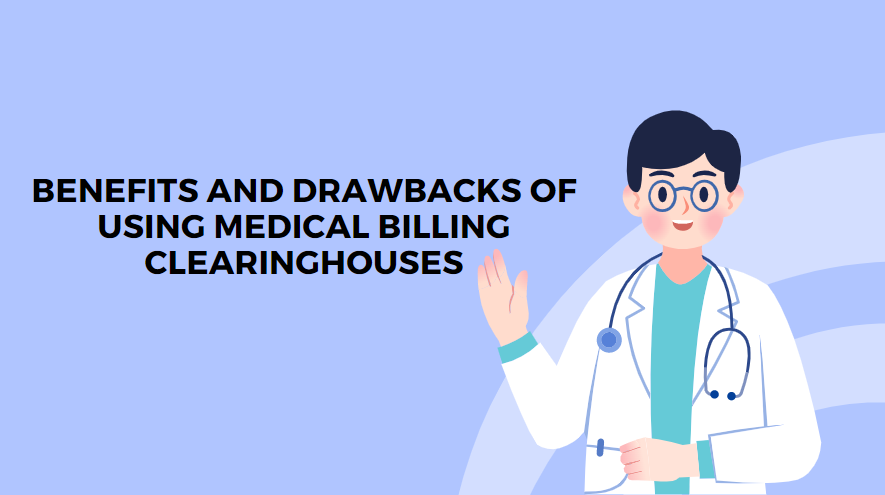Benefits and Drawbacks of using Medical Billing Clearinghouses .In the healthcare industry, medical billing is a crucial aspect that ensures healthcare providers receive payment for the services they render to patients.

Benefits of Using Medical Billing Clearinghouses
- Increased Efficiency One of the primary benefits of using medical billing clearinghouses is increased efficiency. Clearinghouses can process medical billing claims more quickly and accurately than healthcare providers can on their own. Clearinghouses use electronic submission and processing systems. Which eliminates the need for manual data entry and reduces the chances of errors.
- Cost Savings Using medical billing clearinghouses can also result in cost savings for healthcare providers. By outsourcing their billing processes to a clearinghouse. Providers can reduce the amount of time and resources they spend on billing-related tasks. This, in turn, can lead to lower overhead costs and increased profitability.
- Improved Accuracy and Compliance Medical billing clearinghouses are responsible for ensuring. That submitted claims are accurate and compliant with relevant regulations. By using a clearinghouse, healthcare providers can reduce the risk of errors and increase their compliance with regulations. Which can help them avoid costly penalties and legal issues.
- Better Communication Medical billing clearinghouses act as a liaison between healthcare providers and insurance companies. They can help facilitate communication between the two parties, which can lead to faster resolution of billing-related issues.
Benefits

- Enhanced Efficiency: One of the primary advantages of using medical billing clearinghouses is the significant improvement in efficiency. These platforms automate the process of claim submission, reducing the time and resources required for manual paperwork. By electronically transmitting claims to various payers, clearinghouses expedite reimbursements and minimize the risk of errors commonly associated with manual data entry.
- Claim Scrubbing and Error Detection: Clearinghouses employ advanced software algorithms to scrub claims for errors and inconsistencies before submission. This proactive approach helps identify and rectify billing mistakes, such as missing information or coding errors, before they reach the payer. Consequently, healthcare providers experience fewer claim rejections and denials, leading to faster reimbursement cycles and improved cash flow.
- Streamlined Communication: Medical billing clearinghouses serve as intermediaries between healthcare providers and insurance companies, facilitating seamless communication. They act as a central hub for transmitting electronic transactions, including claims, eligibility inquiries, and remittance advice. This centralized approach simplifies administrative tasks and fosters better collaboration between stakeholders, ultimately improving the overall efficiency of the revenue cycle.
- Compliance and Regulatory Adherence: Keeping pace with the evolving regulatory landscape can be daunting for healthcare providers. Medical billing clearinghouses alleviate this burden by staying abreast of industry regulations and compliance requirements. By ensuring that claims adhere to coding standards and billing guidelines, clearinghouses help mitigate compliance risks and minimize the likelihood of audits or penalties.
Drawbacks of Clearinghouses
- Cost While using a medical billing clearinghouse can result in cost savings in the long run. There are still costs associated with using these services. Healthcare providers must pay fees to the clearinghouse for their services, which can eat into their profits.
- Lack of Control When healthcare providers outsource their billing processes to a clearinghouse. They are relinquishing some control over the billing process. This can be concerning for providers who prefer to have more direct control over their billing processes.
- Data Security Using a medical billing clearinghouse requires sharing patient data with a third-party entity. This can raise concerns about data security and privacy, particularly if the clearinghouse experiences a data breach.
- Potential for Errors While medical billing clearinghouses are designed to reduce the risk of errors, they are not foolproof. Mistakes can still occur. Healthcare providers must be vigilant in reviewing and verifying all billing information submitted through a clearinghouse.
Drawbacks of Medical Billing Clearinghouses:
- Data Security Concerns: Transmitting sensitive patient information through third-party clearinghouses raises concerns about data security and privacy. Despite stringent security measures implemented by clearinghouses, the risk of data breaches or unauthorized access cannot be entirely eliminated. Healthcare providers must prioritize robust data encryption protocols and compliance with HIPAA regulations to safeguard patient confidentiality and mitigate potential liabilities.

- Cost Considerations: While medical billing clearinghouses offer undeniable benefits, they also come at a cost. Healthcare providers must pay subscription fees or transaction charges to access these services, which can vary depending on the volume of claims processed. For smaller practices or organizations with limited resources, these expenses may pose a financial challenge and impact profitability.
- Limited Control Over Processes: Relying on external clearinghouses means relinquishing some degree of control over the billing process. While automation streamlines operations, it also reduces the provider’s ability to customize workflows or address unique billing requirements. Additionally, delays or disruptions in clearinghouse services could adversely affect revenue cycle management, highlighting the importance of contingency plans and backup systems.
- Dependency on Technology: The seamless operation of medical billing clearinghouses hinges on the reliability of technology infrastructure and connectivity. Any disruptions or outages in electronic systems could disrupt claim processing and hinder reimbursement cycles. Healthcare providers must assess the robustness of clearinghouse platforms and have contingency measures in place to mitigate the impact of technological failures.
Case Studies: Share real-life examples or case studies of healthcare providers who have successfully implemented medical billing clearinghouses in their practices. Highlight the specific challenges they faced, how clearinghouses addressed those challenges, and the outcomes achieved in terms of improved efficiency, revenue optimization, or patient satisfaction.
Comparison Guides: Create side-by-side comparison guides that evaluate different medical billing clearinghouse providers based on criteria such as pricing, features, customer support, and user reviews. This resource can help healthcare providers make informed decisions when selecting a clearinghouse that aligns with their specific needs and preferences.
FAQ Section: Develop a comprehensive FAQ section addressing common questions and concerns about medical billing clearinghouses. Cover topics such as how clearinghouses work, their benefits and limitations, integration with existing systems, data security measures, and the process of selecting a clearinghouse vendor. Use clear and concise language to demystify complex concepts for readers.
Legal and Regulatory Updates: Provide updates on relevant legal and regulatory developments impacting medical billing practices, such as changes to healthcare legislation, updates to billing codes and guidelines, or enforcement actions related to compliance violations. Offer practical tips for staying compliant with regulatory requirements when utilizing medical billing clearinghouses.
Success Stories: Share success stories from healthcare providers who have achieved tangible benefits from using medical billing clearinghouses, such as increased revenue, reduced claim denials, improved billing accuracy, or streamlined administrative workflows. Include testimonials or quotes from satisfied clients to add credibility and authenticity to the narratives.
Implementation Guides: Offer step-by-step implementation guides to help healthcare providers seamlessly integrate medical billing clearinghouses into their existing workflows. Provide actionable tips, best practices, and troubleshooting advice to address common implementation challenges and ensure a smooth transition to using clearinghouse services.
Interactive Tools: Develop interactive tools or calculators that allow healthcare providers to estimate potential cost savings, revenue increases, or efficiency gains associated with adopting medical billing clearinghouses. These tools can help providers quantify the value proposition of clearinghouse solutions and make data-driven decisions.
Training Resources: Curate training resources, such as webinars, video tutorials, or downloadable guides, to educate healthcare staff on effectively using medical billing clearinghouses. Cover topics such as navigating clearinghouse platforms, interpreting remittance advice, resolving claim rejections, and optimizing billing workflows for maximum efficiency.

Feedback and Reviews: Encourage readers to share their experiences and feedback about using medical billing clearinghouses in the comments section of your blog. Monitor and respond to comments to foster engagement and address any questions or concerns raised by readers. Incorporate constructive feedback into future blog posts or content updates to continuously improve the value proposition for your audience.
Conclusion
Medical billing clearinghouses can offer several benefits, including increased efficiency, cost savings, improved accuracy and compliance, and better communication. However, there are also potential drawbacks to consider. Such as cost, lack of control, data security, and the potential for errors. Healthcare providers should weigh the pros and cons of using a medical billing clearinghouse . Before deciding whether or not to use these services. Ultimately, the decision will depend on the specific needs and priorities of each individual provider.

Recent Comments